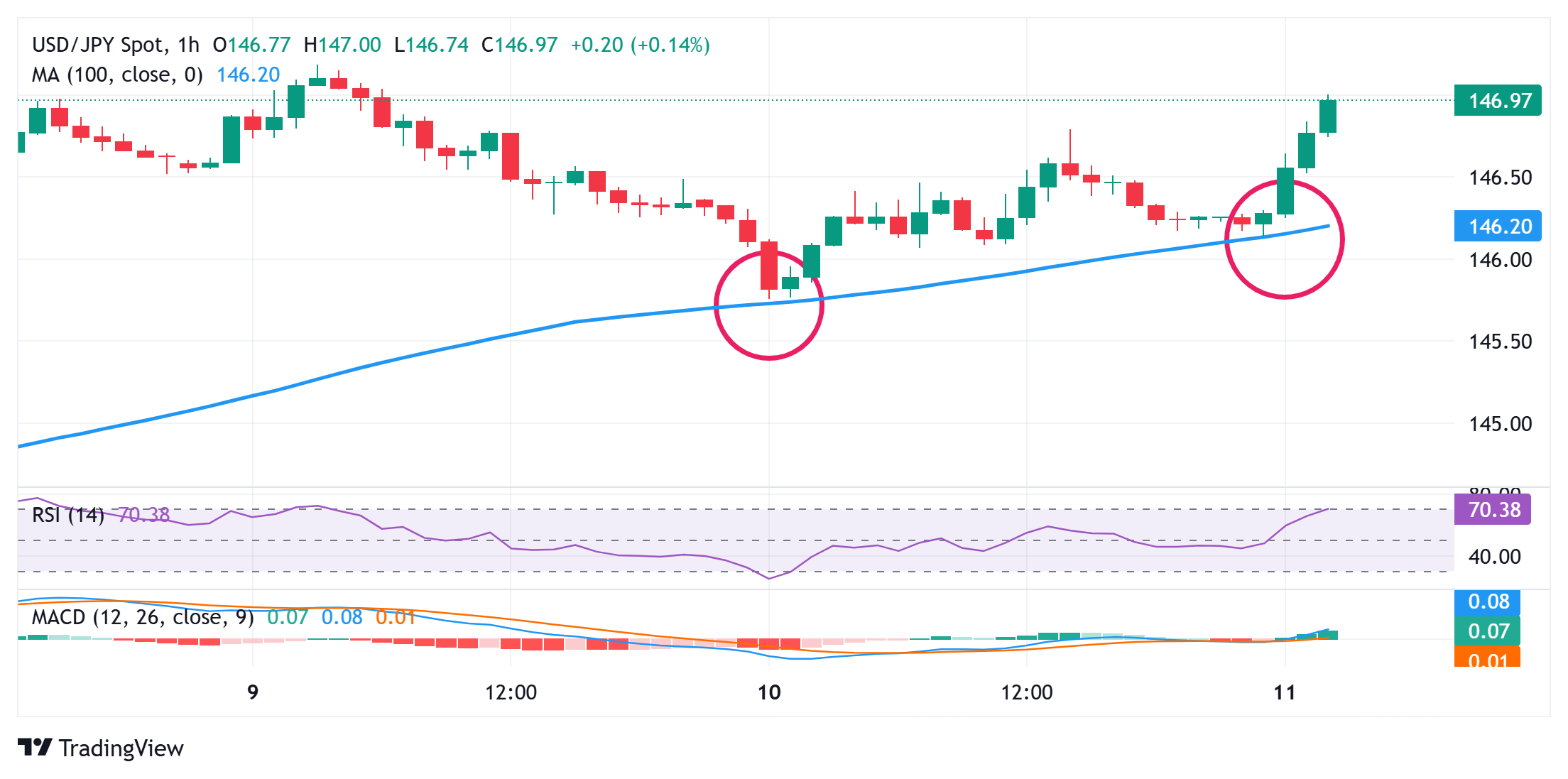Japanese Yen struggles near multi-week low against USD; seems vulnerable to slide further
- The Japanese Yen meets with a fresh supply as traders pare BoJ rate hike bets amid rising trade tension.
- Domestic political uncertainty also undermines the JPY and provides a goodish lift to the USD/JPY pair.
- The USD sits near a two-week top amid reduced Fed rate cut bets and contributes to the pair’s move up.
The Japanese Yen (JPY) maintains its heavily offered tone against a broadly firmer US Dollar (USD) through the Asian session on Friday, with the USD/JPY pair looking to build on the positive momentum beyond the 147.00 mark. Concerns about the potential economic fallout from US tariffs, along with declining real wages and signs of cooling inflationary pressures, might force the Bank of Japan (BoJ) to forgo raising interest rates this year. This has been a key factor behind the JPY’s sharp decline since the beginning of the current week.
Apart from this, domestic political uncertainty contributes to the JPY’s relative underperformance. The USD, on the other hand, flirts with over two-week high touched on Thursday amid diminishing odds for an immediate interest rate cut by the Federal Reserve (Fed). This provides an additional boost to the USD/JPY pair. In the absence of any relevant market-moving economic data from the US, spot prices remain on track to end the week on a stronger note and the supportive fundamental backdrop backs the case for additional near-term gains.
Japanese Yen remains heavily offered on the back of US tariff jitters
- US President Donald Trump reignited trade war concerns this week and issued notices to key allies, including Japan, outlining individual tariff rates starting August 1. Japan faces a punishing 25% tariff on all exports to America amid stalled US-Japan trade negotiations, particularly over Japan’s protection of its rice market.
- Japan’s Prime Minister Shigeru Ishiba called the move truly regrettable and said that bilateral talks would continue in pursuit of a mutually beneficial outcome. Japan hopes to arrange meetings between its chief negotiator, Ryosei Akazawa, and US Treasury Secretary Scott Bessent during his visit to the World Expo on July 19.
- Meanwhile, data released this week showed that Japan’s real wages in May fell at the fastest pace in 20 months. Adding to this, Japan’s Producer Price Index hinted that inflation pressures might be cooling off. This, along with rising trade tensions, could complicate the Bank of Japan’s plans to normalize its monetary policy.
- Recent media polls raised doubts about whether Japan’s ruling coalition of the Liberal Democratic Party (LDP) and Komeito will be able to secure enough seats to maintain their majority at the upper house election on July 20. This further adds a layer of uncertainty and continues to undermine the Japanese Yen.
- The US Dollar trades with a positive bias near its highest level in more than two weeks as traders temper their expectations for a rate cut by the Federal Reserve later this month. This further contributes to the USD/JPY pair’s strong move up during the Asian session and supports prospects for additional gains.
- Meanwhile, San Francisco Fed President Mary Daly said on Thursday that monetary policy is still restrictive, and it’s time to think about adjusting the interest rate. Tariffs aren’t as high as they were expected to be, and economic fundamentals support a move toward lower rates at some point, Daly added further.
- Separately, Fed Board of Governors member Christopher Waller noted that tariff inflation effects are likely to be short-lived and that a rate cut here would not be politically motivated. Waller – one of the possible favorites to replace Powell in 2026 – made another push for an early interest rate cut in July.
- In contrast, St. Louis Fed President Alberto Musalem said that it was too soon to tell if tariffs will have a one-off or a more persistent impact on inflation. The economy is in a good place, and it is critical for the Fed to keep long-term inflation expectations anchored, Musalem added further.
- On the economic data front, the US Department of Labor (DOL) reported that Initial Jobless Claims fell to 227K for the week ending July 5. The reading was less than consensus estimates and the previous month’s downwardly revised reading of 232K, pointing to a still resilient US labor market.
- There isn’t any relevant market-moving economic data due for release from the US on Friday, leaving the USD/JPY pair at the mercy of the USD price dynamics. Nevertheless, spot prices remain on track to register strong weekly gains as the focus now shifts to US inflation figures next week.
USD/JPY acceptance above 147.00 sets stage for a further near-term gains

From a technical perspective, the USD/JPY pair attracts dip-buyers near the 100-hour Simple Moving Average (SMA) support for the second straight day. A subsequent strength beyond the 147.00 mark will be seen as a fresh trigger for bullish traders on the back of positive oscillators on hourly/daily charts. Spot prices might then climb towards an intermediate hurdle near the 147.60-147.65 region and eventually aim to retest the June swing high, around the 148.00 round figure.
On the flip side, any corrective pullback might continue to find decent support near the 100-hour SMA, currently pegged near the 146.20 zone. Some follow-through selling, leading to a subsequent break through the 146.00 mark, might shift the bias in favor of the USD/JPY bears. The downward trajectory might then extend towards the 145.50-145.45 area en route to the 145.00 psychological mark.




